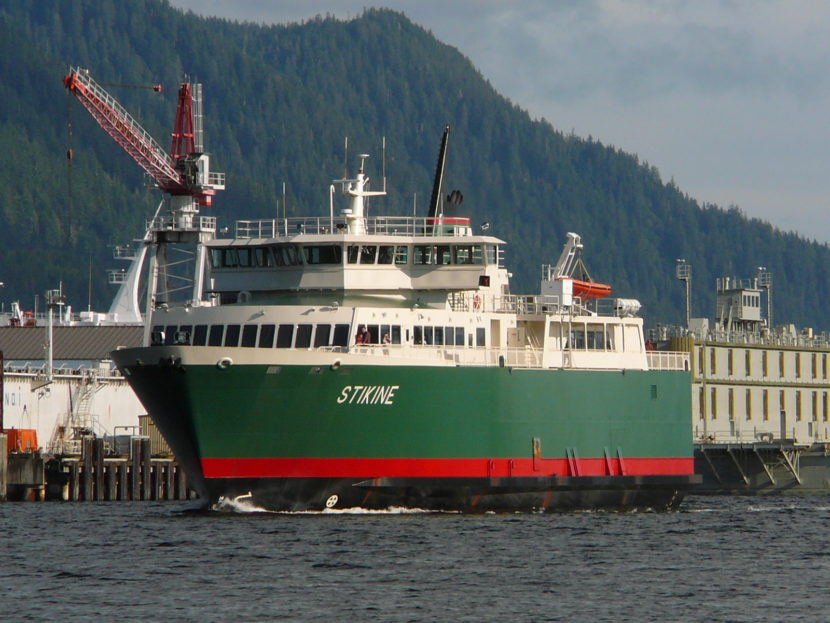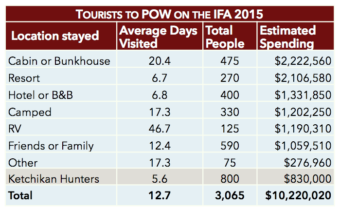
An independent southern Southeast Alaska ferry system contributes $52.2 million a year to the region’s economy. The Inter-Island Ferry Authority just released a report showing its impacts on tourism, seafood, health care and other industries.

The Inter-Island Ferry Authority, or IFA, has been sailing for about 15 years. It runs between Hollis on Prince of Wales Island and Ketchikan. It’s separate from the much larger Alaska Marine Highway System.
“We move people, we move vehicles, we move freight,” said General Manager Dennis Watson, who is also mayor of Craig. “We take people to town to shop or for health care reasons or to vacation, or we bring tourists out to the island and bring them back to Ketchikan.”
A new report funded by the IFA takes a look at what its approximately 50,000 passengers meant for the economy in 2015. The state ferry system released a similar report recently.
Meilani Schijvens runs Rain Coast Data, a Juneau-based research firm hired to produce the IFA document. She said fishermen and processors who depend on the IFA contributed $11.2 million that year.
“Businesses build their business models around having the IFA to transport fresh, high-valued and live seafood products. There’s geoducks. There’s oysters and there are different products that without the IFA, these businesses wouldn’t exist,” she said.
The report said last year’s total economic impact for Prince of Wales Island was $19.4 million. The impact on Ketchikan was $21.6 million.
Schijvens said islanders traveling to Ketchikan for medical care made up around a third of the spending.

“I think because you have the IFA there, the medical facilities in Ketchikan are able to have more services and have services that are targeted at a larger population than just the Ketchikan population,” she said.
The ferry authority, which is owned by Prince of Wales communities plus Wrangell, pays for 85 percent of its costs through the fare box. The state ferry system covers less than half that rate.
The rest of the IFA’s funding comes from the state and federal governments, though the state didn’t come through this budget year.
IFA’s Watson said despite Alaska’s tight budget, he hopes the legislature will resume chipping in.
“I’m going to hand-deliver a copy of this report to every office on the hill. And they need to see it, because people who live around Fairbanks and other places that don’t have ferries and don’t need marine transportation the way we do need to understand what we’re about,” he said.
The ferry authority owns two almost identical ships, the Prince of Wales and the Stikine. That’s because it used to have a northern route connecting Coffman Cove to Wrangell and Petersburg.
It shut down because it didn’t attract enough traffic and lost too much money. But the IFA still has both ships.
Watson said the authority looked into selling one to save money. But it decided it was crucial to have a backup.
“If something should happen to the vessel that happens to be working at a time and you have to pull it offline, it has a huge domino effect. We just have point A to point B. If something happens, we’re usually on top of it,” he said.
Watson said having only one ship would mean canceling sailings for a month every year for maintenance and inspections. With tourists in the summer, school travel in the winter and seafood year-round, he said that would hurt people at both ends of the route.
The state ferry Lituya used to fill in when IFA’s Hollis-to-Ketchikan ferry was down. But Watson said the small ship had difficulty handling rough weather along the route.
The Inter-Island Ferry Authority was started to boost service to Prince of Wales. State ferries used to stop there, but not as frequently as now.
Still, Watson said the two systems support each other.
“In order for IFA to survive, we have to have a marine highway system that has a reasonable schedule. Because what we’re doing is we’re providing access from Prince of Wales Island either to the southern or northern mainland highway system,” he said.
A separate, smaller ship began sailing the IFA’s old northern route in 2015. The Rainforest Islands Ferry runs five months a year out of Coffman Cove, stopping in Wrangell and a landing around 30 miles south of Petersburg.
